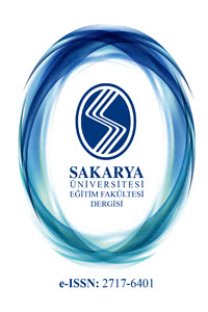ÖĞRENCİLERİN FONKSİYONLARDA İŞLEMLER KONUSUNA GRAFİKLER ÜZERİNDEN YAKLAŞIMLARININ İNCELENMESİ
Öğrencilerin fonksiyonlarda işlemler konusuna grafikler üzerinden yaklaşımlarını incelemek amacıyla yapılan bu çalışma özel durum niteliği taşımaktadır. Öğrencilerin daha önceden karşılaşmadıkları ve dolayısıyla didaktik antlaşmasına uygun olmayan sorulara verdikleri cevaplar çoklu temsiller ve didaktik antlaşması kavramları yardımıyla analiz edilmiş ve öğrencilerin grafik okuma ve oluşturma becerileri ile ilgili çeşitli kestirimlerde bulunulmuştur. 65 lise son sınıf öğrencisinin çalışma grubunu oluşturduğu çalışma 2010-2011 öğretim yılında İstanbul’da üç farklı lisede uygulanmıştır. Verilerin analizinden elde edilen en önemli sonuç, cebirsel işlemleri yapmada çok iyi durumda olan öğrencilerin aynı başarıyı grafiklerle ilgili işlemlerde gösteremedikleri görülmüştür. Ayrıca kavramsal anlamanın yetersizliği nedeniyle birçok öğrenci grafiklere fonksiyon kavramından bağımsız bir yaklaşımda bulunarak soruyu yanıtlamaya çalışmıştır.
Anahtar Kelimeler:
Fonksiyon, fonksiyonlarda işlemler, grafik, çoklu temsiller, didaktik antlaşması
INVESTIGATION OF STUDENTS’ APPROACHES TOWARDS OPERATIONS ON FUNCTIONS VIA THEIR GRAPHIC REPRESENTATION
Designed as a case study, in this study, it is aimed to investigate students’ approaches towards operations on functions via the graphic representation of the functions. Students’ answersto the questions that they have never met and that are not convenient to the didactic contract are analyzed in terms of multiple representation and didactic contract concepts. Furthermore, several estimations on students’ skills about reading and drawing graphics have been made. The sampling of this study consists of 65 last grade high school students from 3 different high schools in Istanbul. The most important result gathered from the analysis of data is that the success of students is not as well at operations on graphics as at algebraic operations. Besides, most of students tried to answer the questions independently of function concept because of lack of conceptual understanding
Keywords:
functions, operation on functions, graphical representation, multiple representations, didactic contract,
___
- Adıgüzel, T. Ve Akpınar, Y. (2004). Improving school children’s mathematical word problem solving skills througt computer-based multiple representation (ERİC Documentation Reproduction Service No. ED 485 024).
- Akkoç H.(2006). Fonksiyon kavramının çoklu temsillerinin çağrıştırdığı kavram görüntüleri,H.Ü. Eğitim fakültesi dergisi, 30, 1–10.
- Bloch, I. (2000). L'enseignement de l'analyse à la charnière lycée / université. Savoirs, connaissances et conditions relatives à la validation. Thèse doctorat, Université Bordeaux I.
- Bloch, I. (2003). Teaching functions in a graphic milieu: what forms of knowledge enable students to conjecture and prove?,Educational Studies in Mathematics 52,3–28.
- Brenner, M. E., Mayer, R. E., Moseley, B., Brar, T., Duran, R., Reed, B. S. & Webb, D. (1997). Leaming by Understanding: The Role of Multiple Representations in Leaming Algebra, American Educational Research Journal, 34 (4), 663-689.
- Brenner, M.E., Brar, T., Duran, R., Mayer, R.E., Moseley, B., Smith, B.R., ve Webb, D. (1995). The role of multiple representations in learning algebra. (ERİC Documentation Reproduction Service No. ED 391 659).
- Brousseau G. (1994). Perspectives pour la didactique des mathématiques, in M. Artıgue et col. (eds), Vingt ans de didactique des mathématiques en France : Hommage à Guy Brousseau et Gérard Vergnaud, Grenoble : La Pensée Sauvage, 51-66.
- Brousseau, G. (1998). Théorie des situations didactiques. La Pensée Sauvage éditions Grenoble, 1998 Collection : Recherches en Didactique des Mathématiques
- Capraro, M. M., Kulm, G., Capraro, R. M. (2005). Middle grades: Misconceptions in statistical thinking. School Science and Mathematics Journal, 105, 165-174.
- Duval R. (1993). Registres de représentation sémiotique et fonctionnement cognitif de la pensé. Annales de didactique et de Sciences Cognitives (IREM de Strasbourg), 5, 37-65.
- Kaput, J.J. (1989). Linking representations in the symbolic systems of algebra. In S. Wagner & C. Kieran (Eds.), Research agenda for mathematics education: Research issues in the learning and teaching of algebra (pp.167- 194). Reston, VA: National Council of Teachers of Mathematics.
- Keller, B.A. ve Hirsch, C. R. (1998). Student Preferences for Representations of Functions. International Journal of Mathematics Education in Science and Technology, 29 (1), 1-17.
- Kieran, C. (1992). The learning and teaching of school algebra. In D. Grouws (Ed.) Handbook of research on mathematics teaching ant learning(pp. 390-419). New York: Oxford University Press.
- Lacasta, E. (1995). Les graphique cartésiens de fonctions dans l’enseignement secondaire des mathématiques : illusions et contrôle, Thèse de doctorat, Université Bordeaux I.
- Lesh, R., Doerr, H. (2003). Foundations of a models and modelling perspective on mathematics teaching, learning and problem solving. In R. Lesh & H. Doerr (Eds.) Beyond constructivisim: A models and modeling perspectives on mathematics problem solving, learning and teaching.. Mahwah, NJ: Lawrence Earlbaum.
- Lincoln, Y. S., Guba, E.G. (1985). Naturalistic inquiry. Newburry Park, CA: Sage.
- MEB. (2005). Talim ve Terbiye Kurulu Baskanlığı, Ortaöğretim Matematik Dersi Öğretim Programı. Ankara: MEB Basımevi.
- Miles, M., Huberman, A. M. (1994). Qualitative data analysis: an expanded sourcebook. Thousand Oaks, CA: Sage.
- Nadia, A. (2004). Enseignement des fonctions en France et en Palestine. Analyse comparative de deux choix de transposition didactique, Thèse de doctorat, Université ParisVII.
- Özgün-Koca, S. A. (2004). Bilgisayar Ortamındaki çoğul Bağlantılı Gösterimlerin Öğrencilerin Doğrusal İlişkileri Öğrenmeleri Üzerindeki Etkileri, Hacettepe Üniversitesi Eğitim Fakültesi Dergisi, sayı 26.
- Shah, P., Hoeffner, J. (2002). Review of graph comprehension research: Implications for instruction. Educational Psychology Review, 14(1), 47-69.
- Yavuz, İ. (2010). What does a graphical representation mean for students at the beginning of function teaching. International Journal of Mathematical Education in Science and Technology, 41/4, 467-485.
- Yıldırım, A., Simsek, H. (2005). Sosyal Bilimlerde Nitel Araştırma Yöntemleri, (5.Baskı). Seçkin Yayıncılık, Ankara.
- ISSN: 1303-0310
- Yayın Aralığı: Yılda 2 Sayı
- Başlangıç: 2001
- Yayıncı: Sakarya Üniversitesi
Sayıdaki Diğer Makaleler
ÖĞRETİM KADEMESİNE GÖRE ÖĞRENCİLERİN HİKÂYE UNSURLARINA İLİŞKİN BEKLENTİLERİ
KUŞAKLAR ARASINDAKİ İLETİŞİMDE ETKİLİ VE KALICI DİL EĞİTİMİNİN ÖNEMİ
21. YÜZYILDA OKUL YÖNETİCİSİNİN NİTELİĞİ: ÖĞRETİM LİDERLİĞİ
AKADEMİK KOÇLUK SİSTEMİNİN ÖĞRENCİLERİN AKADEMİK BAŞARISINA ETKİSİ
ÖĞRENCİLERİN FONKSİYONLARDA İŞLEMLER KONUSUNA GRAFİKLER ÜZERİNDEN YAKLAŞIMLARININ İNCELENMESİ
İlyas YAVUZ, İbrahim KEPCEOĞLU
ÖĞRENCİ SEÇME SINAVINA (ÖSS) GİRECEK ÖĞRENCİLERİN MATEMATİK İLGİSİ ÜZERİNE BİR ÇALIŞMA
